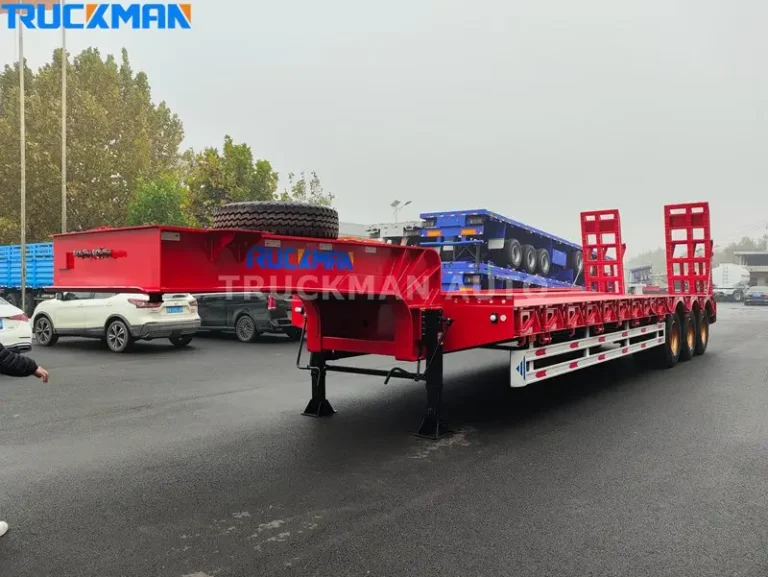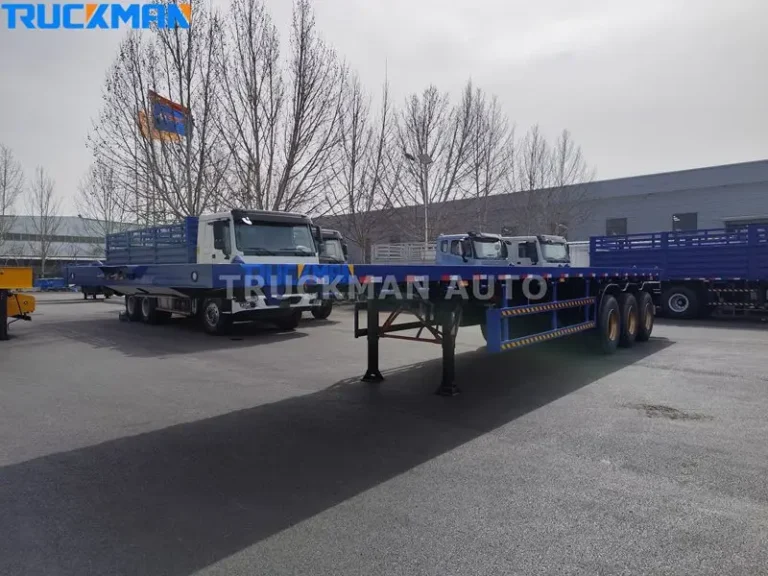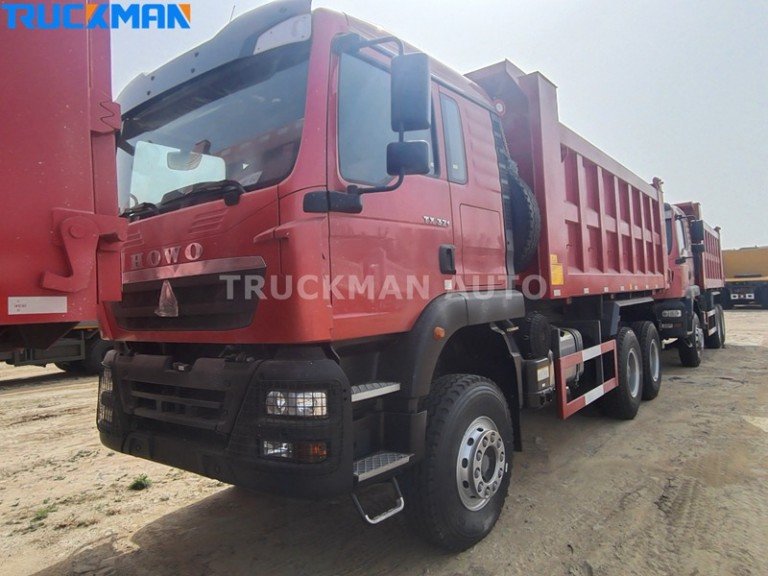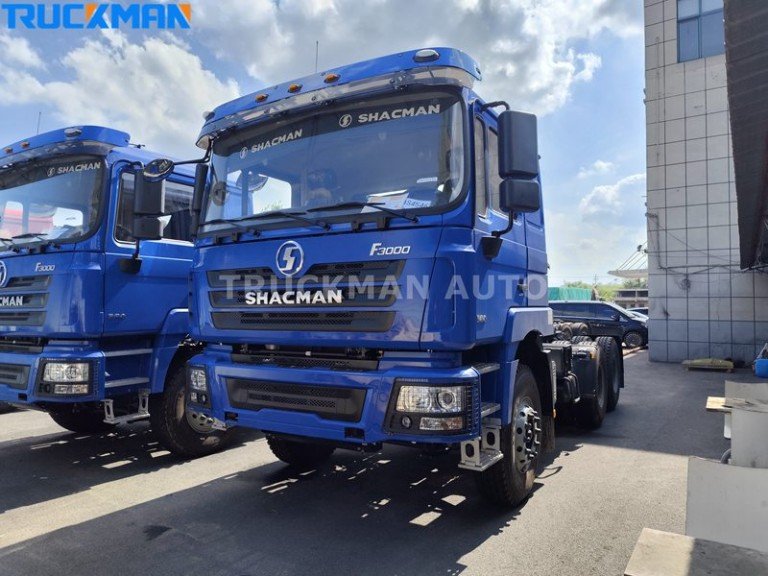Gooseneck trailer is a type of trailer that is specifically designed for the transportation of heavy cargo. It is a specially customized version of the common flatbed trailer type. Its unique detachable structure makes it an ideal transportation trailer when moving heavy loads such as large equipment, construction materials and agricultural machinery. This is because this trailer offers stability and maneuverability.
But from time to time, customers ask: how much does a gooseneck trailer weigh? In today’s article, Truckman will answer this question for you in detail. Understanding the load capacity of gooseneck trailers can also be a guiding reference for you to choose the right trailer in the future. Thus, you can choose the model and configuration that better meet your needs.

Table of Contents
What is a gooseneck trailer?
So what is a gooseneck trailer? What are its features? Gooseneck trailers get their name from their unique gooseneck-shaped towing device. This gooseneck hitch connects the deck as well as the tow vehicle. Compared to traditional bumper trailers, this trailer design shifts the connection point to near the center of gravity. This change effectively distributes the weight of the trailer, thus improving stability. Secondly the gooseneck section, can be selectively removed for different loading and unloading needs. This allows for easy loading and unloading of cargo with greater convenience. And during transportation, only the trailer and the front end need to be connected to start the transportation task.
As a key tool widely used in heavy transportation. Its unique design allows for high maneuverability in the transportation of large cargoes. It also provides a flexible turning radius for more convenient transportation tasks. Therefore, when choosing the right gooseneck trailer, it is essential to know its weight as well as its load capacity. This can help you choose the type of trailer for the corresponding transportation task.
Weight range of gooseneck trailers
Gooseneck trailers offered by Truckman are mainly designed for heavy duty transportation. As compared to the regular trailer types, our trailers are built with sturdy construction as well as the use of high-strength materials. This increases the overall deadweight while catering to higher loads. Below are a few general attributes that we have compiled:
Average Empty Weight
The average empty weight of different gooseneck trailer models ranges from (5-12 ton) 11,023 lbs to 26,455 lbs. The range of empty weight depends on the complexity of the trailer’s size and design as well as the materials used. For example, the difference in empty weight between a 2-axle and 4-axle trailer can be 15,432 pounds (7 tons). We offer the following conventional models with empty weights
- 50 Ton Gooseneck Trailer: Empty weight of approximately 5-7 tons (approx. 11,023-15,432 lbs.). Ideal for medium-weight cargo transportation, with excellent flexibility for various transportation tasks.
- 80-ton gooseneck trailer: weighs approximately 7-9 tons empty (approx. 15,432-19,841 lbs.). It is designed for transporting heavy equipment and large industrial machinery, providing better stability over long distances.
- 100 Ton Gooseneck Trailer: weighs approximately 9-11 tons empty (approximately 19,841-24,251 lbs ). Ideal for transporting large construction materials and overweight cargo, this vehicle offers superior load-carrying capacity.
- 120 Ton Gooseneck Trailer: approximately 12 tons (approximately 26,455 lbs). It is designed for ultra-heavy industrial and construction tasks, ensuring a high degree of stability under maximum loads.
Payload capacity
The payload capacity of the trailer ranges from (50-120 tons) approximately 110,231 to 264,555 lbs. Specific load capacity is affected by trailer configuration and number of axles. Models with more axles and reinforced chassis typically have higher load capacities and are suitable for hauling extra-long, extra-heavy loads. Common models are:
- 50 ton gooseneck trailer: 50 ton load capacity
- 80 ton gooseneck trailer: 80 ton capacity
- 100 tons gooseneck trailer: load capacity 100ton
- 120 Ton Gooseneck Trailer: 120 ton capacity
Customization: Truckman also offers customized trailers with greater capacity.
Start your project today with a custom semi-trailer solution designed to meet your unique hauling needs.
Factors affecting the weight of a gooseneck trailer
Above we have learned about the information regarding the weight capacity of a gooseneck trailer. So what are the specific factors that affect trailer weight? We have compiled some of the relevant factors below. Hope this can better help you make a choice.
- Material selection: the common types of material are steel and aluminum. Steel is usually used to make heavy duty trailers due to its high strength and has a higher carrying capacity, but has a higher empty weight. In contrast, aluminum can effectively reduce the trailer’s dead weight and improve fuel efficiency. However, it has a lower load carrying capacity. So choosing the right material needs to be weighed against transportation needs and budget. This way you can find the best balance between durability and cost control.
- Axle Configuration: The number of axles directly affects the carrying capacity of a gooseneck trailer. More axles mean greater weight dispersion and a higher load limit. For example, a 50-ton trailer might be equipped with two axles. A 120-ton trailer, on the other hand, typically requires four axles to ensure stability and safety when transporting overweight cargo.
- Trailer Size: The size (length and width) of a trailer also affects its weight and load capacity. Longer or wider trailers are able to carry larger or longer loads, but they also increase empty weight. Therefore, you need to choose different sizes of trailers for different types of cargo.
- Choose according to use: Different types of cargo require different trailer configurations. For example, when transporting machinery and equipment, you need to choose a trailer with high carrying capacity and extended deck to ensure the stability and safety of the equipment. And when transporting containers, you should choose a gooseneck trailer that fits the standard container size to ensure loading efficiency and transportation safety.
- Consider trailer configuration: the number of axles of the trailer is an important factor in determining its load-bearing capacity. Twin-axle design is suitable for medium load transportation needs, providing good maneuverability and flexibility. Multi-axle design, on the other hand, is suitable for overweight cargo and long-distance transportation, improving load dispersion and stability. When choosing a trailer, the appropriate configuration should be selected according to the weight of the cargo and the transportation distance.
- Legal Requirements: When choosing a gooseneck trailer, you need to ensure that the trailer complies with relevant international and Chinese domestic laws and regulations. For example, transportation of goods of specific weight and size may have different regulations in different regions. Therefore, before selecting and using a trailer, you should carefully check the licensing requirements, height and width restrictions, etc. of the place of transportation to ensure compliance and safety of the operation.
Conclusion
Understand the weight of a gooseneck trailer and its carrying capacity. This is extremely important in choosing the right model to ensure safe and efficient transportation.At Truckman, as a semi-trailer manufacturer in China, we offer a wide range of specifications and configuration options. Customization options are also available to tailor the design to your needs. This can maximize your specific transportation needs. We also offer comprehensive after-sales support and expert consulting services if there are any problems. They can help you find the best solution for your transportation needs. Contact us for a detailed quote or ask one of our experts for more information.






